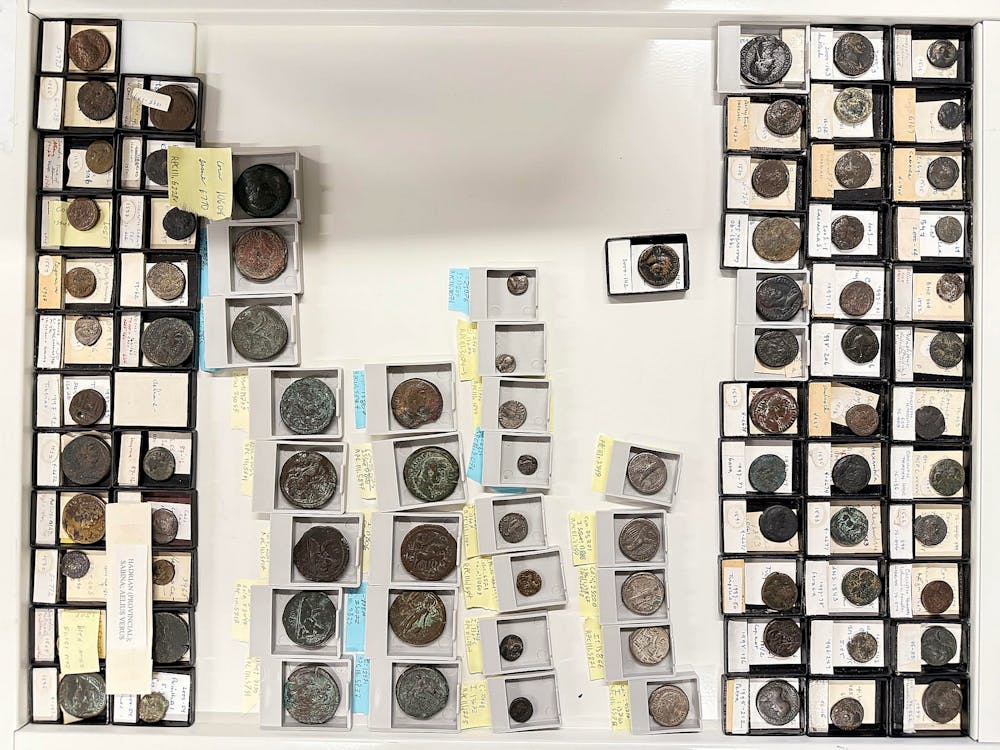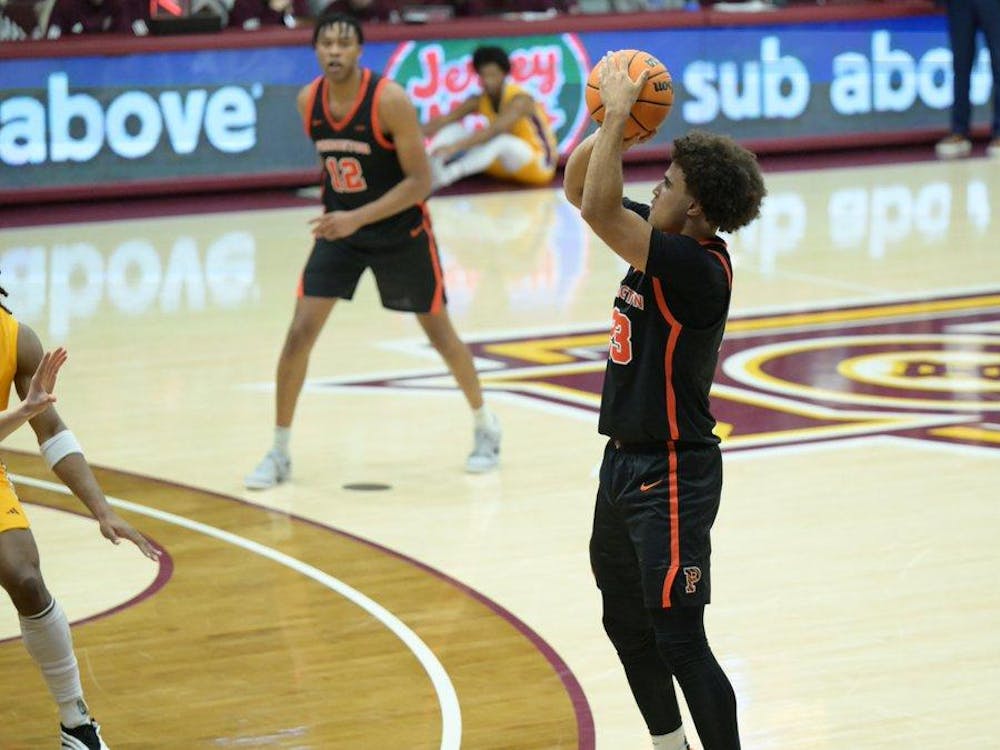Not many people today can say they have touched a Roman coin from around 100 CE.
Reza Ramji ’28, a student from the Classics Department and a coin cataloguer at Princeton University’s Numismatic Collection, is among the select few who have. “The seal has been worn away by a few hundred years of people who have handed this one off to another, and you are one of the four people this millennium who have touched this coin,” Ramji said.
The Roman coin from Emperor Hadrian’s era that Ramji held was small and rusty. It belongs to a collection of 125,000 coins, tokens, and banknotes housed in Firestone Library’s C Floor. A historical treasure trove, this collection ranges all the way from a late-seventh-century BCE Lydian electrum coin to a gilt “Medal for Victory” from 1998 Cuba.
“This university has lots of collections of old things, but for the most part, classes or individuals can’t just come in and pick up a piece,” said Alan Stahl, Curator of Numismatics. “So, it’s a very direct contact with the past.”
As one of the few collections affiliated with academic institutions, Princeton’s world-class numismatic collection is at the University community’s fingertips in its entirety through an online database, exhibitions, courses, and in-person appointments with the curator. Through continuous digitalization efforts in recent decades, the collection is becoming increasingly accessible to people around the world.
Started in 1849 with an alumni donation of plaster casts of Greco-Roman coins, the collection is the United States’ oldest continuously curated public coin collection. Over the next century, the Numismatic Collection expanded through various donations from friends of the University.
“To some extent, it went hand-in-hand with interest in the academic community here in working with coins,” Stahl told the ‘Prince.’ “It wasn’t just that the coin department built itself, but it’s been increasingly used for coursework and student study and publication and the like.”
A landmark in the history of the collection is the Princeton-led excavations in the ancient city of Antioch, present-day Turkey, between 1932 and 1939, through which the University was given possession of 24,000 coins from Classical and Late Antiquity. The excavations, which would not have been possible in the Ottoman Empire before World War I, were authorized under the French Mandate for former Ottoman territories, according to Stahl.
According to Stahl, the numismatics office has been integrating the Antioch coins into the collection while simultaneously working with professionals on other aspects of the excavation to jointly study coins with other relevant artifacts. These include the ancient pottery housed in the Princeton University Art Museum and the archival books and archaeological notes from the Department of Art and Archaeology.
Another highlight of the collection is its Byzantine coinage: At more than 20,000 pieces, it is the largest holding of its kind in the world and is the most representative of different coin types. In 2016, English-born coin collector Peter Donald approached Princeton with his extraordinary collection of 5,280 Byzantine coins. The sale was made possible by funding primarily from the Seeger Center for Hellenic Studies and the Friends of the Princeton University Library. Following the attention generated by this initial acquisition, the family of the late collector Chris B. Theodotou also contacted Princeton, and the University went on to purchase his collection of 11,256 coins in 2022.
According to Stahl, Princeton approached these purchases with a firm understanding of “the total cost of ownership,” a frequently cited term in modern-day museum circles that refers to the comprehensive expenses of curatorship: museums must not only consider the cost of acquiring artworks and artifacts, but also cataloging, installing, and conserving them in the long term.
“It’s one thing to find the money to buy stuff, but that’s useless unless you have organized the resources of getting it all catalogued and online and in exhibits and known to the rest of the world,” Stahl said.

One individual’s work has been instrumental to the Donald and Theodotou acquisitions. Elena Baldi, a specialist in Byzantine coins at Special Collections, has not only been cataloguing all the coins, but is also in the process of launching a Linked-Open-Data system — an open-access website for scholarly research which includes a homepage for each type of coin and lists all the appropriate references and pictures of identical coins in other collections worldwide.
Linked-Open-Data systems had previously been developed for coins from ancient Greece, the Roman Republic, and the Roman Empire, but Baldi’s project is expanding it to Byzantium. This collaborative project brings together professionals from Dumbarton Oaks, the Harvard University research institution on Hellenic studies, as well as the University of Oxford, the University of Trieste, and the American Numismatic Society.
According to Stahl, the principle that has guided the Numismatic Collection for the past two decades is clear: “Everything should be visible to the entire world for free over the web.”
Stahl, who began his numismatic curatorship at Princeton in 2004, set up the collection’s first online database using a model from the American Numismatic Society, where he had previously worked for 20 years as a curator. As of now, about 25,000 coins, or one-fifth of the total coinage, have been catalogued online in a significantly improved database — a process that continues today.
Apart from experts like Stahl and Baldi, the University’s students are also actively involved in the collection’s work. In fact, most of the coin cataloguing is done by students on the basis of student employment.
Ramji spends a few hours working at the Numismatic Office every week. Since last year, he has been cataloguing coins from the era of Emperor Hadrian, starting with coins minted in the city of Rome, and currently working on coins from Roman provinces. His work involves identifying the coins’ visual patterns — which might be a portrait of Hadrian, the god Nile, or Athena — and Latin scripts, and then matching them with coins already indexed in a central database.
“I really enjoy getting the chance to touch ancient history in a way that a lot of other artifacts don’t really let you do for preservation reasons,” Ramji said. Sometimes the deterioration of the coins’ surfaces obscures their identifying information and makes his work especially time-consuming, but he considers a way to experience to observe humanity’s connection to the coins.
Ramji’s passion for physical culture and history is shared by Massimiliano Dalmasso GS, a PhD student in the Department of History specializing in Byzantine history. Dalmasso, who began his studies at Princeton four years ago, took Stahl’s graduate seminar, CLA 548: Introduction to Ancient and Medieval Numismatics, and immediately developed an interest in numismatics after a hands-on research project using coins on Princeton’s campus.

Massimiliano Dalmasso GS holding a Byzantine coin.
Yi (Chris) Xin / The Daily Princetonian
Dalmasso emphasized that the collection is an important yet rare asset for education. “Not many universities can pride themselves on having such a large collection,” he said. According to Dalmasso, in Europe — where he is from — students of history, archaeology, or classics hardly have the material possibility to work with coins and develop expertise in numismatics.
“That’s a shame because in certain domains, coins are essential for doing research in a solid way,” Dalmasso said. For example, he explained that questions of numismatics are indispensable studies in the economic history of the early modern period. “Even in art history, you cannot ignore the patrimony that coins represent for the movement of styles.”
While Dalmasso is presently cataloging unidentified coins from Princeton’s Antioch excavations, he also plans to introduce the Numismatic Collection to the University’s greater community.
As a Residential Graduate Student at Yeh College, Dalmasso is curating a coin exhibition at the Choi Dining Hall. On display will be several pieces from the collection, organized chronologically, from ancient Persian coins to Classical Greco-Roman and Hellenistic coins, to coins, prints, and even paper money from the modern world.
“It’s about encouraging students to engage with numismatics,” Dalmasso remarked. “But it’s also about taking pride in what we have as Princeton.”
According to Stahl, the integration of coins into students’ academic life is the most exciting aspect of Princeton’s Numismatic Collection. He teaches a general introduction to ancient and medieval coinage in the Classics Department and a course on Antioch in the Art and Archaeology Department.
This past week, Stahl showed coins from the collection to students from multiple sessions of CLA 219: The Roman Empire, and HIS 205: The Byzantine Empire. His students from several other courses this semester have worked with coinage, including ART/ARC 233: Renaissance Art and Architecture, ART 513: Art of the Roman Colonies, and HUM/NES 247: Near Eastern Humanities I.

Students from HIS 205 “The Byzantine Empire” examine Byzantine coins from the Numismatic Collection.
Yi (Chris) Xin / The Daily Princetonian
“Teaching is very important to me,” Stahl said. “[It’s] having [the coins as] part of the curriculum, not only for people who want to take a course on coinage, but people who are doing a course on history or in archaeology.”
He recalled a typical scene from the class visits to the collection: “Even some of the most skeptical of students who sit in the back of the room and don’t show any attention while I’m giving the slide-illustrated introduction, the minute the coins are passed around, they say, ‘Oh, do you mean that Julius Caesar might actually have touched this coin?’ And [I say,] ‘Yes, there’s no reason to discount that.’”
If the delicate visual reflections of thousand-year histories on coins are not already thrilling enough, then the possibility of touching Caesar’s fingerprints offers yet another compelling reason to visit Princeton’s Numismatic Collection.
Yi (Chris) Xin is a Features contributor for the ‘Prince.’
Please send any corrections to corrections[at]dailyprincetonian.com.








